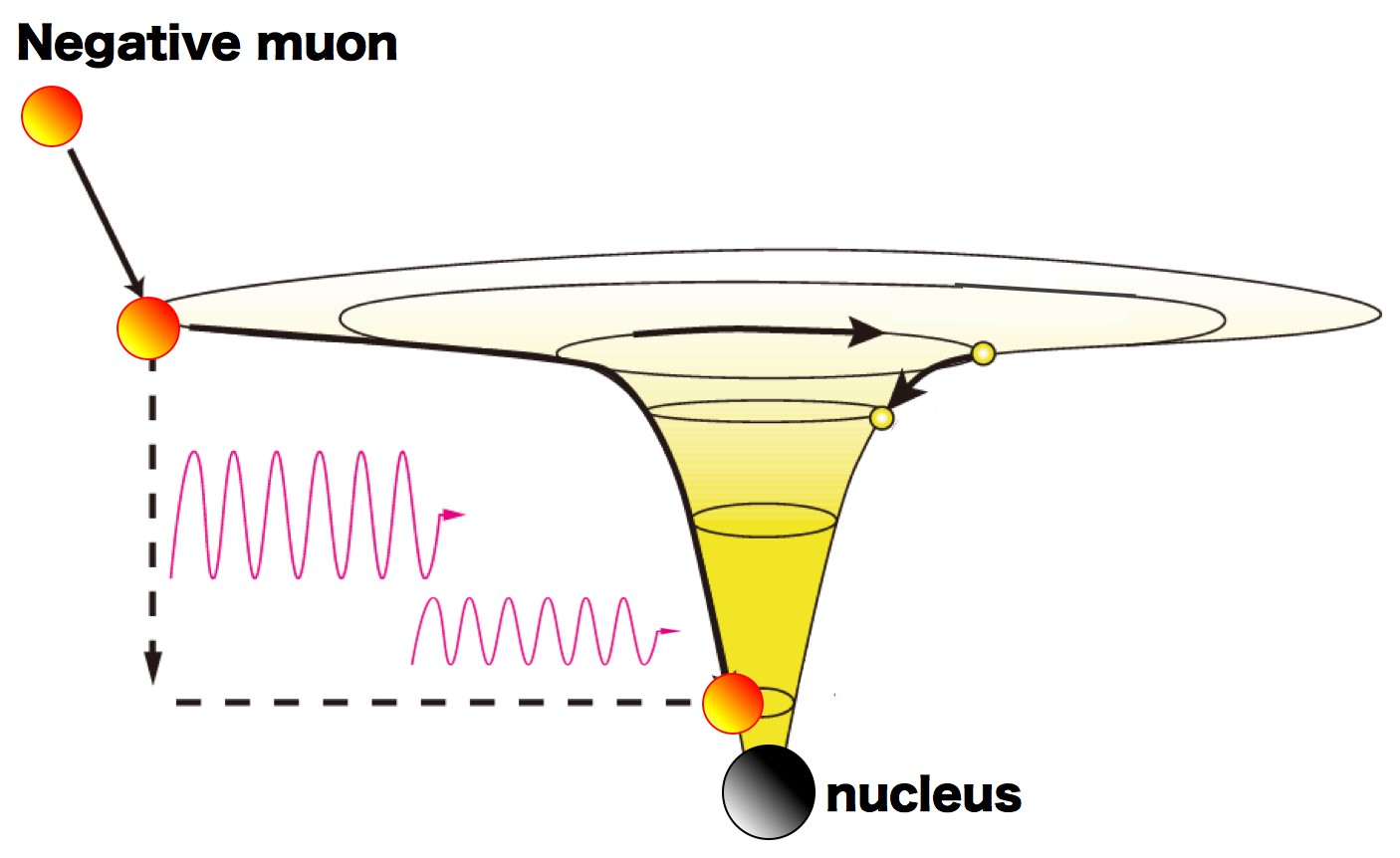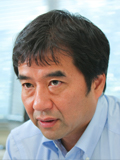| Program A01 | Precision measurements in atomic and molecular physics using a negative muon beam and its application to observations in astrophysics |
|---|---|
| Principal Investigator | AZUMA, Toshiyuki (RIKEN) |

Muonic atom formed
by capture of a negative muon to a nucleus, and emitted muonic
X-rays during de-excitation
Looking at the process of capturing negative muons in detail, the
negative muon is captured into a highly excited state of an atom, and
then it steps down to the next lower energy level one after another
in a much shorter time than the intrinsic lifetime of the negative
muon. Initially, all (or many) of the bound electrons originally
bound by the atom are peeled off and emitted as Auger electrons, and
a muonic atom composed of a negative muon and an atomic nucleus, that
is, an exotic hydrogen-like multiply-charged ion produced in
vacuum. From this state, muon characteristic X-rays are further
emitted along with the transition between the levels, and the
negative muon finally reaches the ground level.
Research aiming to the high scientific goal to answer the fundamental
questions of space, such as elementary particle physics experiments
and space observations, are often results of the uninterrupted
pursuit of sensitivity and resolution. By the advanced detector with
the extreme performance, the x-ray spectroscopy of the muonic atom,
one of the most clean atomic systems, is performed in the precision
far exceeding the conventional accuracy over a wide band. This is
expected to provide the benchmark data suitable for the model
validation and precise understanding of the electronic recombination
process in X-ray astrophysics.
In this research, we prepare isolated muonic atoms in vacuum by
stopping the negative muon in a dilute gas target using the
low-velocity negative muon beam of the world's highest intensity. The
stopping position of the muon atom at an accuracy of 0.1 mm is
tracked by a CdTe hard X-ray imager developed for space
observation. By a multi-pixel superconducting transition edge
microcalorimeter (TES) detector, the energy of emitted muonic X-rays
of several keV (electron volt) will be measured at high resolution of
several eV (ΔE/E ∼ 0.001). In this research,
we aim to simulate the radiation spectrum obtained by actual
astrophysical observation utilizing the code calculation of the
refined de-excitation and recombination process, and to develop the
results widely to X-ray astrophysics.
Members
| Principal Investigator | AZUMA, Toshiyuki (RIKEN Cluster for Pioneering Research) |
 |
|---|---|---|
| Co-Investigators | WATANABE, Shin (JAXA) | |
| YAMADA, Shinya (Rikkyo University) | ||
| ICHINOHE, Yuto (Rikkyo University) | ||
| BAMBA, Aya (The University of Tokyo) | ||
| INOUE, Yoshiyuki (Osaka University) | ||
| Research Collaborators | TAKAHASHI, Tadayuki (The University of Tokyo) | |
| OKADA, Shinji (Chubu University) | ||
| NINOMIYA, Kazuhiko (Osaka University) | ||
| KINO, Yasushi (Tohoku University) |
Reference Materials
- Hitomi Collaboration, Y. Ichinohe, A. Bamba, Y. Inoue, T. Takahashi, S. Watanabe, S. Yamada et al., “Atmospheric gas dynamics in the Perseus cluster observed with Hitomi,” Publ. Astron. Soc. Jpn. 70, 9-1–32 (2018), DOI: 1-10.1093/pasj/psx138 .
- T. Hashimoto, Y. Ichinohe, S. Okada, S. Yamada et al., “Beamline test of a transition-edge-sensor spectrometer in preparation for kaonic-atom measurements, IEEE Trans. Appl. Supercond. 27, 2100905 (2017), DOI: 10.1109/TASC.2016.2646374 .
- Y. Nakano, Y Enomoto, T. Masunaga, S. Menk, P. Bertier, T. Azuma, “RICE: RIken Cryogenic Electrostatic ion storage ring,” Rev. Sci. Instrum. 88, 033110 (2017), DOI: 10.1063/1.4978454 .
- S. Okada, S. Yamada et al., “First application of superconducting transition-edge sensor microcalorimeters to hadronic atom X-ray spectroscopy,” Prog. Theor. Exp. Phys 2016, 091D01 (2016), DOI: 10.1093/ptep/ptw130 .
- H. Tatsuno, S. Okada et al., “Absolute energy calibration of X-ray TESs with 0.04 eV uncertainty at 6.4 keV in a hadron-beam environment,” J. Low Temp. Phys 184, 930-937 (2016), DOI: 10.1007/s10909-016-1491-2 .
